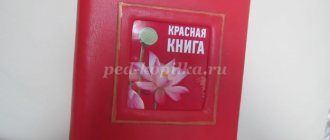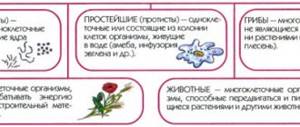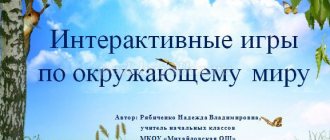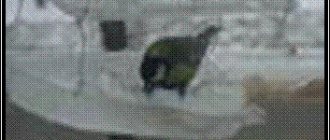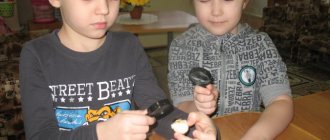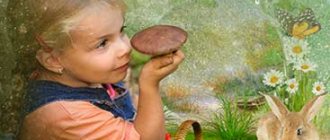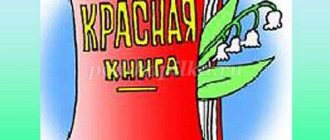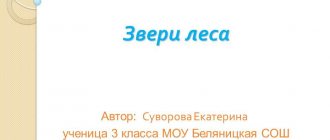For the curious: about forest babies and their mothers. Interesting information about animals in spring
Hares in spring
Mom is a hare
feeds the bunnies and immediately runs away, leaving them alone under a bush. And the bunnies sit under the bush for three to four days, waiting for their new mother, the hare, to feed them.
There are no strangers' bunnies - they are all their own and will always be fed. Hares' milk is fatty and nutritious; it lasts for 3-4 days.
Why does nature work this way? The fact is that hares have sweat and sebaceous glands only on the soles of their paws. And if the hare lived with the hares, they would quickly be found - smelled by the smell - a fox or a wolf. After all, rabbits have many enemies - fox, wolf, marten, lynx, and birds of prey. And when a tiny bunny sits under a bush and hides its paws under itself, it is impossible to find it by its smell. It turns out that by running away from the bunnies, the hare saves them.
After 8-9 days, the rabbits will have teeth, and then grass will appear, and they will begin to feed themselves.
Squirrels in spring
At the squirrel's
Baby squirrels also appear in the spring. They are born naked, helpless, and cannot see anything. The mother squirrel takes care of them, feeding the squirrels milk for two months. But dad, the squirrel, doesn’t live with his family, he lives separately.
The mother squirrel spends a lot of time searching for food, otherwise the baby squirrels will grow up frail and sick. Baby squirrels require special attention from the mother squirrel; they need to be covered, warmed, and fed. Only after a month do the baby squirrels open their eyes and begin to look out of the nest.
In spring, the squirrel is the enemy of all birds and the most dangerous predator for many birds. She destroys bird nests on tree branches and steals chicks and eggs from them.
Hedgehogs in spring
In April, hedgehogs also appear. They are born in a hedgehog's nest, which looks like a hut made of dry leaves, twigs and moss. The hedgehog feeds the hedgehogs with milk and takes care of them.
Hedgehogs, like baby squirrels, are born helpless and naked, without needles. A few hours after birth, bumps appear on the skin of the hedgehogs, then they burst, and thin needles appear from them. Then the needles will harden and turn into thorns. The mother of the hedgehog first feeds the hedgehogs with milk, and then, when they grow up, she brings them earthworms and slugs to their nest.
Bears in the spring
In April, a mother bear with grown cubs wakes up and leaves the den. She wanders through the forest - looking for food: pulling out bulbs and roots of plants, looking for larvae.
Coming out of the den, the bear stretches, rolls around, tries to warm up after hibernation, and puts his fur coat in order. And looking for food.
By the time they leave the den, bears molt. They lose their thick winter coat and grow a short, darker coat. The fur will grow again all summer and will be thick and warm by the new winter (bears do not shed in the fall).
In the spring, the she-bear not only feeds the cubs with her milk, but also teaches them to get their own food - dig roots out of the ground, look for insects, last year's berries. Even if the mother bear is hungry, first of all she will give food to her babies - the cubs. While protecting the cubs, the mother bear can attack any enemy.
In the spring, the mother bear bathes her cubs in streams and lakes: she takes them by the scruff of the neck and lowers them into the water. Later, when the kids grow up, they will begin to bathe themselves.
Creative task “Unwashed Raccoon”.
Read to the children a wonderful fairy tale about the Raccoon. And together with your child, figure out how this story ends.
E. Shim “Who looks like whom?”
“Little Raccoon ran home, and his mother gasped:
- Fathers, who do you look like?! Where have you been messing around? Why is all the fur in the trash?
- And I was stirring up an anthill.
- Why are your paws covered in swamp mud?
- And I was chasing a frog.
- Why is your nose in the ground?!
- I dug up a beetle...
- No, just look at him! - mom says. – Is this what decent animals look like?
What do decent animals look like?
- Decent animals have shiny fur, licked noses, cleaned claws! And look at yourself!
“I wanted to take a look,” Raccoon replies, “but they didn’t let me.”
- Who didn’t?
- And the Bear. I didn’t come to the river, I went down to the water - suddenly there was a Mother Bear with her cubs! So scary! I'm angry!
- Do you know why she came to the river?
- Don't know. I quickly ran away.
“She brought the cubs to bathe them.” And she is ashamed when the children are grimy!
“That’s it...” says Raccoon. - Now understand. Otherwise, I couldn’t guess why she was waving her paw and growling: “Oh, you little freak, oh you unwashed Raccoon!”
Questions for children:
- Why couldn’t Raccoon look at himself – at his reflection in the water?
- Why did the Bear come to the river? Why did the Bear growl and get angry?
- What did the Raccoon do next when he found out why the Bear was angry and cursed “The Raccoon is unwashed”?
- Together with your children, figure out how this story ends. (For example, Raccoon quickly ran to the river, washed his face, combed his hair, cleaned his claws. He returned home, even his mother did not recognize him, and was very happy...)
Sometimes in a family of bears there is an older bear cub - a “pestun” (a bear cub from last year’s litter). So it is called from the word “nurture”. The bear cub is a nurse - the main assistant of the mother - bear, a role model for kids - bear cubs. He shows them how to climb hollows for honey, how to feast on ants and their larvae. He separates the cubs if they fight and restores order among them. This is the kind of helper the bear has! And daddy bear does not take part in raising the cubs.
The bear cub is a nurturer, although he is an older bear cub, but he loves to play. Read to your child the dialogue between the Magpie and the Teddy Bear:
E. Shim “The Magpie and the Little Bear”
“- Teddy bear, are you going to break this rowan tree?
-Are you bending it into an arc?
- Do you want to rip her off?
- Leave me alone, Soroka. I do not want anything. I just took it and am swinging on this mountain ash. Let me play at least a little before my mother comes and makes my little brother babysit!”
Foxes in spring
Foxes also have cubs. Usually in March - April, a fox gives birth to 4-6 cubs. Little foxes are dark brown in color, and the tips of their tails are white! After 3-4 weeks, the fox cubs stop eating the milk of their mother, the fox, but still live in the hole. Their parents bring them food into the hole.
Their mother, the fox, does not allow anyone near the fox cubs. She guards the hole. The mother fox watches closely to see if there is any danger nearby. In case of danger, the fox barks loudly, and the cubs quickly run away - they hide deep in the hole. And if people or dogs have visited the fox hole, then the fox will definitely move her cubs to another safe place - away from the previous hole. The father fox also helps raise the fox cubs. He teaches them and brings them booty.
Wolves in the spring
To raise wolf cubs, wolves make a den in the forest thicket. In the spring, a she-wolf gives birth to 4-7 cubs. They are born helpless and covered with gray fluff. First, the she-wolf feeds the cubs with her milk, and does not leave them anywhere. And daddy the wolf brings food to the she-wolf. When the wolf cubs grow up, both mother and father feed them together.
Moose in spring
In the spring, a moose cow gives birth to 1-2 calves. The mother moose licks them after birth, and they immediately stand on their legs. And after 3-4 days, little elk calves run after their mother! Their mother, the moose cow, feeds them with her milk for a long time, and the moose calves grow like heroes - by leaps and bounds!
Badgers in the spring
The badger wakes up and crawls out of the hole. The badger is a very neat and clean animal. Therefore, in the spring he begins to repair his house, renews his bedding, cleans the passages, and throws out the garbage.
In the spring, the badger eats everything edible it can find, as it needs to quickly restore strength after hibernation. It eats larvae, earthworms, mice, and destroys bird nests.
In April, a badger gives birth to 3-6 badger cubs. She raises them alone. For several days she does not leave the hole at all, then she comes out, but not for long. To make the babies grow faster, the badger takes them one by one out into the sunshine into the fresh air - she takes them in her teeth, brings them and places them side by side under a bush or under a tree. When the badger cubs are two months old, they come out of the hole on their own.
Pisces in the spring
In the spring, the ice on the river melts and it is no longer possible to walk on it. And then the ice begins to drift completely. All the inhabitants of the reservoirs are happy that it has become light under the water. The fish swim to shallow places where the water is more warmed by the sun.
In spring, fish begin to grow, and their scales grow in rings. And by their number you can determine how old the fish is.
In May, fish spawn. The fry emerge from it.
At first the fry are naked, without scales, then they grow scales. First of all, the pectoral fins of the future fish grow, then the fins on the back, and then on the stomach. When the fry grow up, it develops a tail.
The fry hide from their enemies in the darkness. In some fish, the fry hide in their parents' mouths and sit there in safety. Sometimes the fry hide next to their parents, clinging to their side and swimming away from the dangerous place.
Spring
How animals welcome spring
Spring is a period of new life for all animals. After a long and calm winter, all representatives of the animal world begin to actively prepare for the onset of a hot summer.
Spring days in the life of animals are accompanied by a change in coat - from winter to summer. Squirrels change their gray skin to bright red. They can increasingly be found in parks. Squirrels jump through the trees in search of food.
Chipmunks wake up after hibernation. Outwardly, it can be confused with a squirrel, but the main difference is the five dark stripes on the back. Chipmunks have been stocking up on food since winter, before they hibernate. Therefore, with the arrival of spring, these animals are not puzzled by the search for what they can get enough of.
But bears, also hibernating in winter, do not care about what they will eat after a long sleep. Therefore, in the spring they come out of their dens in search of food.
For wolves, spring is the time when they breed. Little wolf cubs stay in their parents' den until they have the vision to navigate well in space. Being small, they are very similar to foxes, only the tips of their tails are not white, but gray.
Hares begin to shed, exchanging their winter white coat for a gray and less warm coat. Also, raccoon dogs, waking up after hibernation, change their color to a less noticeable one. The color of the coat is of great importance. In winter, the skins are white, this makes it possible to blend into the snow-white cover of the earth if a predator is hunting nearby. Gray wool also serves as a kind of camouflage in summer.
In early spring, hedgehogs wake up, because in April they have to breed.
Migratory birds in spring: logic puzzles for children
Logical problem 3. Each has its own time. Birds in spring
Each bird flies to us at its “own time”. This is how it is written about it in N. Sladkov’s story:
N. Sladkov. Birds brought spring
“The rooks arrived and brought thawed patches. Icebreaker wagtails broke the ice on the river. The finches appeared and the green grass began to fluff.
That’s how spring is done: a little of each.”
Why does each bird have its own time of arrival?
Try to guess it yourself with your children.
“The Crake and the Rook” (E. Shim) will help you guess what the reason is.
“- Crake, why are you late, did you arrive from warm lands so late?
- And I waited until my house grew up.
- How is it that the house will grow?!
- You live in a tree, Rook, you don’t understand. And I live in a clean meadow, hiding in the grass. So I waited for the grass to grow!”
Another hint
- the first to return to us are those birds that were the last to fly away in the fall. And vice versa, the last to return to us almost in the summer are those birds that were the first to fly away from us at the beginning of autumn. Why? Let's remember together with the children why the birds flew away from us in the fall and did not spend the winter with us? They would freeze, they would have no food. So which birds arrive first? Those who can get food for themselves even in March.
Why do swallows arrive only in May? Let's remember how swallows fly close to the ground before the rain - why do they do this? Because they catch insects (in the summer in the village, show this phenomenon to the children). Swallows feed on insects. And when do insects appear in our forests, fields, and gardens? In May. So the swallows come to us when there is food for them.
Logical problem 4. Birds are auditors
“Tractor drivers call these birds “resistors.” As soon as the tractors go out into the spring arable land, these black proud birds are right there - decorously and importantly walking behind the tractor along the freshly plowed strip, picking worms from the ground. What kind of birds are these?”
Why are rooks called “auditors”? Who is an “auditor”? Are rooks migratory or wintering birds? Why do people call rooks “the harbingers of spring”?
Logical problem 5. Why do rooks have a white beak?
Rooks are among the first to arrive to us, proudly walk through the fields, looking for worms, larvae, and beetles in thawed areas.
What color is the rook's beak? White. And some rooks have a beak... black!!! Why do you think? This riddle has a very interesting solution. And the old rook White Beak and the young rook Black Beak will tell you and your children (E. Shim “Black Beak and White Beak”).
It is best to act out this story using figurines of two rooks, painted differently.
“- Rook, you were probably flying to the fire?
- Why is it for a fire?
- Yes, your nose is sooty!
- Why is it sooty?
- Rooks have white noses, but yours is black! It's like they smoked it on purpose!
- And you’re still lying! My nose is normal! And very beautiful! It’s just that I’m still a young rook, I haven’t been in the field much, I haven’t poked around in the ground much... So I didn’t have time to polish my beak until it shines!”
After reading this short story - dialogue, ask your child how to understand - did we meet an old rook in the village in the spring or a young one? Why was the beak of a young rook called “smoky”? (Explain to the child what happens in a fire, what “smoky” means. Remember the soot that children could see at the dacha, the coals from the fire, tell the child that after a fire only black coals remain. And the young rook’s beak is also black. That’s why They called its beak “smoky”).
Entertaining task 6. The secret of the nightingale
In spring nightingales sing. And when do they eat? You won't be full of songs. It turns out that the nightingales have their own secret. Here's what:
“A nightingale sang in the bird cherry trees. He sang without a break, loudly and bitingly. His tongue in his wide-open beak beat like a bell. When only he has time to eat and drink! After all, you won’t be satisfied with just one song. He hung his wings, threw back his head, his sharp beak snapped like scissors in the hands of a deft hairdresser. It clicks and clicks with such sonorous trills that even the neighboring leaves tremble, and warm steam escapes from the heated neck.
...And mosquitoes flock to the park! They can’t sharpen their nose under a tight feather, so they sound over their gaping beak. They just ask to be put in your mouth, they stick right to your tongue! The nightingale clicks songs and... mosquitoes. Two things at once. And one is not a hindrance to the other. And they also say that songs don’t feed the nightingale!”
(N. Sladkov. Nightingale)
For the curious: interesting facts about nightingales in spring
In the first half of May, nightingales return to us. First, the male nightingales fly to us and immediately begin to sing, but they sing still weakly and uncertainly. Their singing is a signal for the female nightingales. When the females arrive, the nightingale songs begin. This bird's voice is amazingly beautiful!
But not every nightingale will learn to sing beautifully. Nightingales take three years to learn to sing! Only in the third year do they become magnificent singers. Young nightingales learn to sing from their neighbors - old nightingales. If the neighbors do not sing very well, then the nightingale does not find its full, beautiful voice. As they say, whoever you get along with, that’s how you’ll gain. This proverb literally refers to the “musical school of nightingale singing,” in which experienced nightingales teach young nightingales to sing.
Nightingale Day is usually celebrated on May 15 - this is the time of sunny, warm spring and nightingale songs. People used to say this: “Nightingales fly when they can drink dew or rainwater from a birch leaf.”
In May - June, nightingales begin to build nests. The nest is made of grass, wool, and dry leaves. The female incubates the eggs for two weeks.
Chicks are born in June. At this time, the nightingale concerts end - the nightingales raise their chicks.
Many have heard the nightingale, but not everyone has seen it. He is invisible. It is very difficult to see the small gray bird.
E. Shim. The nightingale and the little crow
“- Carr! Where are you going, gray, small and squeaky little one? Go away!
- Why?
- The Nightingale lives in these bushes - a golden sock, a silver neck. Are you your equal?
-Have you seen him?
- It hasn’t happened yet. But they say - so good, so handsome! Just to take a peek...
- So look. I am Nightingale!
Creative project on the surrounding world 1st grade. Spring and animals
Creative project on the surrounding world 1st grade on the topic: “Spring changes in the lives of animals”
Author: Sofya Kolos, student of 3 “B” grade at MBOU Gymnasium No. 3, Sharya city, Kostroma region Purpose: This project is intended for primary school students. Application: The material can be used by primary school teachers in lessons about the surrounding world. Relevance: The topic of the project is relevant as environmental education, and is important for the whole society. Purpose: To study the special changes in the lives of animals with the arrival of spring. Objectives: - Visit the local history museum - Visit the school library - Find out what changes happen to animals in the spring - Get acquainted with stories about animals - Observe changes in the lives of animals at the moment With the arrival of spring, nature awakens. And with it the animals that were hibernating. From the encyclopedia, I learned that animals have special clocks in their bodies that keep time regardless of external conditions. At these hours the winter sleepyheads wake up.
The bear wakes up in March and no longer sleeps, but only dozes and waits for suitable weather to leave the den. He has gone hungry during the winter, so he eats everything he comes across: last year’s acorns, grass, roots.
Hedgehogs also lost weight during hibernation. In the spring they wake up and begin to feed heavily on insects. I visited the local history museum and learned that hedgehogs cannot be taken from the forest, because if you later want to release them, they will die, since they are not accustomed to getting their own food and escaping from enemies. In spring it becomes warmer, there is a lot of food for animals and an important event occurs - the birth of cubs.
The fox gives birth to 4 to 6 blind cubs in May. She chooses her den with great care, usually between the roots of large trees. The fox also likes to use other people's holes. The fox cubs do not leave the hole for 3 months. The mother brings them prey.
The she-wolf has 2 or 3 wolf cubs in her lair. The she-wolf chooses a dry, wooded place in a swamp for her cubs, where people and livestock have almost no access. The wolf cubs remain blind for 21 days, behave like young dogs, play happily and fight among themselves like puppies, and their howls and barks can be heard from afar. The she-wolf treats them very tenderly. Wolves raise their cubs until next spring, and then the cubs begin an independent life. All animals molt in the spring. They exchange their warm winter coat for a light one. And the white hare changes its color. It is white in winter and light brown in spring. In the spring, the hare gives birth to offspring. Bunnies are born sighted and wearing warm fur coats. The mother hare feeds them and runs away. And the bunnies run away and hide under the bushes, lying there quietly. Another hare runs past, sees them, and feeds them. This is how it is with the hares: they consider all hares to be common. Immediately after the snow melts, insects begin to appear in sunny weather. On the plants you can see yellow lemongrass butterflies, which overwintered in the cracks of sheds and fences. They can be seen as early as March. I have already observed lemongrass in the yard of my house. All species of lemongrass need protection, like beautiful and harmless butterflies.
With the onset of spring, birds return from warmer climes. From my observations, I can say that rooks and starlings have already arrived in our region.
Insects have appeared, which means there is something to eat. Birds build nests and hatch chicks. If you scare them at this time, the birds may abandon their nests and the chicks will die. Nest destroyers are enemies of nature! Spring signs about birds: I saw a rook - welcome spring.
One swallow... does not make spring.
The swallow begins spring, and the nightingale ends.
In early spring, a crow bathes - to warmth.
The titmouse starts squeaking in the morning - expect frost.
The owl screams... in the cold.
The ducks were playing... in time for the rain.
I like animals a lot. After all, they are part of nature, without which our existence would not be possible. We must take care of every animal in this world. So that forests and gardens and rivers can bloom, take care of all living things in this world. Love nature, Every blade of grass! Be friends with the birds, Take care of the blade of grass. Don’t bring home the hedgehog, Don’t touch the butterfly, Schoolboy, always remember: There aren’t that many of them!
We recommend watching:
Summary of a lesson on the surrounding world for 1st grade Summary of a lesson on the surrounding world in 1st grade on the topic “When did clothes appear?” Lesson summary of the surrounding world in 1st grade. Why will we remain silent in the forest? Lesson on the world around us 1st grade
Similar articles:
Lesson summary of the surrounding world in 1st grade
Lesson summary on the surrounding world in 1st grade on the topic “My helpers are the senses”
Lesson summary on the surrounding world in 1st grade on the topic “Why do you need to eat a lot of vegetables and fruits?”
A story about a dandelion, grade 2. The world
A story about a water lily for 2nd grade. The world
Cartoon birds in spring
And in conclusion, I suggest watching a wonderful cartoon for kids based on V. Bianchi’s fairy tale “The Orange Neck” about a lark and his neighbors - partridges.
From the cartoon, in a very exciting and accessible fairy tale form, children will learn about how birds live.
First, I suggest reading this book to children (it is quite large, so I will not offer its text here; the book “Orange Neck” can be found in any children's library), and then watch a cartoon based on this educational fairy tale.
Our journey into the wonderful world of nature and animals has come to an end. You and your children learned a lot about animals in the spring,
We came up with our own stories and acted out dialogues. I hope that this article will help you and your little ones and bring a lot of joy and amazing discoveries!
You will find more about spring, speech games, poems, physical education lessons, pictures, fairy tales for activities with children in the articles on the site:
https://accounts.google.com
Slide captions:
Municipal state preschool educational institution kindergarten No. 8 Animals and birds in the spring (for preschool age) Educator: Andrusenko O.N. Ostrogozhsk 2020
Animals and birds rejoice at the arrival of spring! Their lives are changing!
In spring, migratory birds return to us from warm countries. Birds are the harbingers of spring! The rooks arrived and the first larks began to sing.
Starlings clean their birdhouses
The birds immediately get to work. We need to have time to build nests, hatch eggs...
... and raise chicks.
But in early spring it can be difficult for birds - it is difficult for them to find food. Don't forget to feed them! Never take bird eggs from a nest!
In the spring, bears, hedgehogs and badgers woke up after their winter sleep.
Many animals give birth to their young in the spring. This little bunny and fox cubs were also born this spring!
In the spring, the she-wolf gave birth to cubs, and the mother bear, cubs. They don't know how to hunt yet, but they love to play!
Look how the baby hedgehogs rush after their mother hedgehog.
Preview:
To use presentation previews, create a Google account and log in to it: https://accounts.google.com
SEASONAL CHANGES IN THE LIFE OF ANIMALS AND THEIR CAUSES
In spring, the animal world wakes up earlier than the plants. The trees are still bare, there is no grass or flowers, and you can see butterflies in the forest and in the city. This is chocolate brown urticaria; yellow-lemon butterfly, which is called lemongrass; with dark and white stripes along the edges - a mourning bowl; with bright iridescent “eyes” on the wings - a daytime peacock eye; whitish color - cabbage. Mosquitoes crawl out of the cracks. And yet, it’s the birds that truly discover spring. The herald of spring is the rook.
This bird is cautious, but it builds nests near dwellings, choosing old willows or birches for this purpose. At this time, rooks can be seen in a noisy company of jackdaws and crows. Following the rooks, starlings, larks, and finches arrive. The weather at this time is unstable, sometimes cold winds blow, making it difficult for the birds. After the opening of the rivers, waterfowl appear, and this parade is opened by the wagtail, which, according to the popular proverb, “breaks the ice with its tail.” In spring, birds are in a hurry, they fly at very high speed, and the entire migration ends faster than in autumn. The bulk of birds arrive at the end of April and beginning of May. The swallow, nightingale and cuckoo arrive later than everyone else; their arrival coincides with the appearance of flies and mosquitoes. The timing of the arrival of birds is mainly related to the availability of the food they need.
At the end of May, the forest is filled with birdsong. Starlings are the first migratory birds to begin singing in the spring. What can you hear in their song: the trill of a nightingale, the sharp cry of an oriole, the sweet voice of a robin, the subtle whistle of a titmouse, and then suddenly they will begin to imitate other sounds: the barking of dogs, the cry of a frog, the cackling of a hen, the creaking of a well and even the sound of a children's trumpet. The starling's singing is joined by the chaffinch's cheerful song. But the real singers are the thrush (songbird) and the nightingale, which fill the forest with melodious trills. The singing of birds is associated with the choice of pairs and the construction of a nest.
Of particular interest is the displaying of black grouse and wood grouse. Black grouse gather in clearings overgrown with bushes, on the edge of moss swamps. Their monotonous muttering (reminiscent of the rattling of a village cart) is composed of several sounds and ends with a loud hissing “chuu-shhh”. The current grouse walks with its tail and wings spread, strongly stretches its neck, crouching and jumping, and at the end of the muttering it scrapes the ground with the end of its spread wings. Wood grouse displays in very remote places. At first he slowly mutters “teke-teke-teke”, then speeding up more and more, and ends with an unpleasant grinding sound. At this time, he does not hear anything (hence his name).
In early May, you can hear the cuckoo cuckooing, with the male cuckooing and the female responding with a trill of “kli-kdi-kli.” In the spring, as a rule, the cooing is long, and in the summer it is very abrupt.
After the eggs are laid, incubation and feeding of the chicks begin? During this period, the forest becomes quieter, since the birds have no time to sing, they have to work from morning to evening. The chicks are constantly hungry, they need a lot of food, as they grow very quickly. By the evening the chick can weigh twice as much as in the morning. Birds have to fly to the nest 500-600 times, destroying thousands of insects. The smallest bird of mixed forests, the kinglet, which weighs only about 6 g, eats the same weight of insects. Granivorous birds also feed their chicks with insects, but when the chicks grow up, they feed on weed seeds, bringing great benefits.
Of particular note is the cuckoo, most species of which do not feed their chicks, but rather lay their eggs in the nests of other birds. Despite the fact that the cuckoo throws its half-brothers out of the nest and its adoptive parents barely have time to feed it, in the future the cuckoo fully justifies the damage it causes to the birds. The cuckoo eats up to 100 caterpillars a day, including hairy and poisonous ones that other birds do not eat. Birds of prey also provide great assistance to people by destroying harmful rodents. An owl saves a whole ton of bread in a year, destroying over 1000 rodents.
As soon as the sun warms the reservoirs with hot rays, a large number of insects begin to swim and breed in them. In the garden, field, forest, flies, beetles, butterflies and other insects fly and crawl. Insects are very prolific. Aphids are considered low-fertile insects, but they produce 12-18 generations over the summer, which is a huge number. And if it were not for ladybugs and their larvae (a ladybug eats about 100 aphids a day, and a larva eats up to 250), then many plants, deprived of juices, would die.
There are a lot of harmful insects, so it is necessary to know those animals that help humans in pest control. These are, first of all, ants, which are forest nurses. During the summer months, the average anthill destroys over 5 million insects (mainly the larvae and caterpillars of many forest pests). Anthills usually last for many years and increase in size every year. Predatory beetles are useful - ground beetles, which destroy a huge number of caterpillars and slugs. Among insects, the dragonfly is strikingly voracious, eating hundreds of harmful insects during the day.
The fish begin their spring move. They rush to the upper reaches of rivers to spawn eggs at their sources (otherwise they will be washed away into the sea). Pike spawn first, then chub; ruffe, catfish, and perch spawn in April; roach and minnows spawn in May.
The grass frogs wake up earlier than other frogs. It is easy to distinguish them from sharp-faced ones by their abdomen: in the grass one it is spotted, in the sharp-faced one it is yellowish or white. Frogs spawn, each with an average of 3 to 7 thousand eggs, but during the development period (an average of about 2.5 months), most of the eggs and tadpoles die. Among frogs, males sing, organizing frog concerts in which you can hear rumbling, moaning, and gurgling. After 2-3 weeks, tadpoles appear and motionlessly attach to the plant; they breathe through gills.
They don’t have a mouth yet, but it will appear in a few days, and the tadpoles will immediately begin to scrape the surface of the plants. Gradually they become more active, and their appearance also changes. Instead of gill tufts, gill slits are formed, which then become overgrown. When they reach land, they develop lungs. First, the hind legs are formed and the tail is preserved, and then the front legs, and at this time the tail disappears completely. The little frog leaves the pond, but forever retains a connection with it.
Spring brings big changes to the lives of mammals. Fur-bearing animals shed, shedding their warm fur, replacing it with lighter, summer hair (at the end of May, most animals' molting ends).
Many animals give birth to offspring in the spring. Hares have babies (from 8-12) in March, when the frosts are still quite strong, which is why they are also called crustaceans (at this time the snow melts during the day and freezes at night, forming a dense crust). They are born developed, with open eyes. The hare feeds them heartily and then leaves. Then any hare that runs past can feed them. 3-4 feedings are enough, since after a week their teeth grow and they begin to feed on their own.
The squirrel gives birth to 5-6 blind and helpless cubs, only after a month and a half do they begin to run quickly. Squirrels and hares can have up to three broods per season, especially when there is enough food. In April, the she-wolf gives birth to offspring. Wolves usually make their lair in a remote place. The wolf feeds the growing wolf cubs with semi-digested food, obtaining it far from its lair, and when the wolf cubs grow teeth, they learn to kill the prey brought to them, and then hunt with their parents.
The fox makes a hole in a secluded place or uses a ready-made hole (for example, a badger hole). She has more than a dozen cubs, so parents have to work hard to feed them. The mother feeds them milk for a short time, and then begins to bring birds and mice, gradually teaching them to catch live prey. It is easy to find a fox hole, because the area around it is very dirty and littered with bones. After 9-10 months, the fox cubs become independent. Both parents take part in raising the young.
The earliest cubs, already in February, appear in the mother bear's den (as a rule, no more than 2-3). They are born blind, small (the size of a three-day puppy) and after a few days they regain their sight. The bear feeds them until April, losing a lot of weight in the process. Then he takes the cubs out of the den. During this period, bears eat everything from insects to random carrion. A meeting with a she-bear at this time is very dangerous, as she protects the cubs from anything that seems suspicious to her.
In May, helpless, naked, blind cubs (3-5) are born to hedgehogs. They grow very quickly and within a month they begin to lead an independent life. Hedgehogs are very useful animals; they destroy large numbers of insects, slugs, mice and attack vipers without fear.
Mink, marten, and other animals have babies. Cubs will also be born in the spring among ungulates: roe deer and elk.
Summer is characterized by the development and increase in offspring in all animals. This is the most favorable time for life: a lot of light and warmth, a lot of food. On hot days, midges, horseflies, and mosquitoes torment not only livestock, but also wild animals that hide from them in water or in open areas. Many insects fly over the flowering meadows, among which the bumblebee, the best pollinator of clover, stands out with its loud buzzing. In June, the hubbub of vocal birds is interrupted by the friendly squeaks of chicks. “Hunting” birds begin to moult: black grouse (siberian grouse), wood grouse, ducks.
In shallow water, crayfish hide in burrows; they have shed their tight shell and now involuntarily hide until a new one is formed.
In early July, bats and lizards hatch. There are many different beetles in the meadows and forests, the chirping of grasshoppers and crickets does not stop, colorful butterflies and dragonflies flutter. At this time the fish becomes lethargic and bites poorly. In August, birds begin to gather in flocks and migrate. Many animals grow up with young animals that begin an independent life. It is time for fish in reservoirs to feed and grow their young. Gradually, all living things are preparing to welcome autumn.
Slide captions:
The little bunny jumped all winter in a white fur coat. But now he no longer needs it, because there is no snow! He hurries to change into a gray summer coat.
Have you seen insects in winter? Probably not, because they were all asleep. And we woke up in the spring!
Spring came cheerfully from the forest,
The bear responded to her, purring from sleep.
The bunnies galloped towards her,
A rook flew to her;
The hedgehog rolled after him like a prickly ball.
The squirrel was alarmed, looking out of the hollow - the fluffy one waited for light and warmth!
The brightened forest stood proudly;
A chorus of birds rang out on the brown branches.
